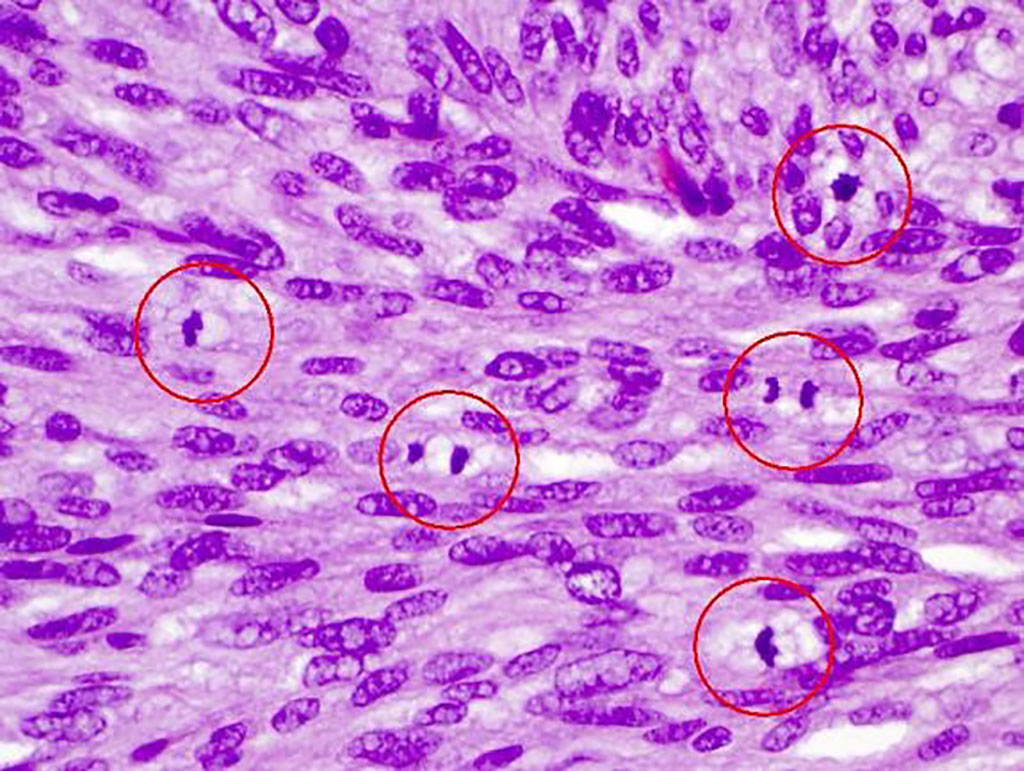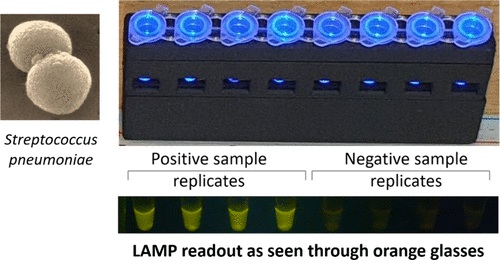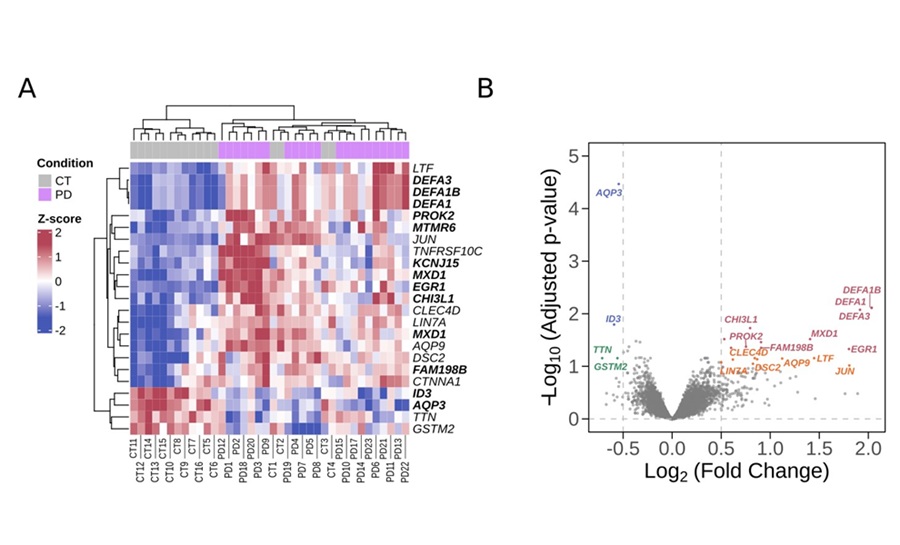Calculation of Melanoma Mitotic Rate Standardized on Whole Slide Images
|
By LabMedica International staff writers Posted on 19 Oct 2021 |

Image: Mitotic Rate and Melanoma Diagnosis: The higher the mitotic count (circled), the more likely the tumor is to have metastasized (Photo courtesy of Arlen Ramsey)
Mitotic rate is an important factor with prognostic relevance in melanoma as well as in other neoplasms. Higher mitotic activity correlates significantly with reduced survival, and is an important parameter in prognostic models offering tailored predictions of prognosis for individual patients with melanoma.
However, accurate mitotic figure counting on hematoxylin-eosin–stained sections can be labor-intensive and challenging. Ideally, the area of the lesion containing the most mitotic figures (the “hot spot”) is identified, and then the mitotic rate is calculated in a 1-mm2 region encompassing the hot spot. The recent availability of digital whole slide image (WSI) data sets from glass slides creates new opportunities for computer-aided diagnostic technologies.
Pathologists at the University of Texas MD Anderson Cancer Center (Houston, TX, USA) established a standardized method to enclose a 1-mm2 region of interest for mitotic figure (MF) counting in melanoma based on WSIs and assess the method's effectiveness. They retrospectively searched their institutional pathology database and chose 30 melanoma cases with reported mitotic figures ranging from 0 to 28. The WSIs for these 30 melanoma cases were created by digitally scanning the original H&E-stained glass slides at ×20 magnification with a ScanScope digital pathology system (Aperio, Vista, CA, USA) with SVS format.
Mitotic figures were defined as the unequivocal presence of extensions of chromatin (condensed chromosomes) extending from a condensed chromatin mass, corresponding to either a metaphase or telophase figure. For each WSI, the mitotic rate was evaluated by first finding the hot spot (i.e., the region of the lesion containing the most mitotic figures) and then counting mitotic figures beginning in the hot spot and then extending to the immediately adjacent non-overlapping viewing fields until an area of tissue corresponding to 1 mm2 was assessed. Fixed-shape annotations with 500 × 500-μm squares or circles were applied depending on the specimen orientation during mitotic figure counting, because this approach is able to achieve convenient annotation and efficient counting while ensuring easy transition from traditional glass slides.
The scientists reported that of the monitors they examined, a 32-inch monitor with 3840 × 2160 resolution was optimal for counting MFs within a 1-mm2 region of interest in melanoma. When WSIs were viewed in the ImageScope viewer, ×10 to ×20 magnification during screening could efficiently locate a hot spot and ×20 to ×40 magnification during counting could accurately identify MFs. Fixed-shape annotations with 500 × 500-μm squares or circles can precisely and efficiently enclose a 1-mm2 region of interest. Their method on WSIs was able to produce a higher mitotic rate than with glass slides.
The authors concluded that mitotic figure counting in melanoma using WSIs is equivalent to using glass slides and can be efficiently done in real practice. In terms of annotation methodology, they recommended fixed-shape annotations with 4 squares or 5 circles in a setting of 500 × 500 μm to cover a 1-mm2 region. The pathologist can easily enclose the region of interest of the tumor and effectively match up irregular tumor regions with position adjustments of the four squares or five circles. If the tumor has a large contiguous area, a single-square annotation of 1000 × 1000 μm can be used. Their methodology can be potentially extended to calculating mitotic rate in other tumors. The study was published in the October, 2021 issue of the journal Archives of Pathology and Laboratory Medicine.
Related Links:
University of Texas MD Anderson Cancer Center
Aperio
However, accurate mitotic figure counting on hematoxylin-eosin–stained sections can be labor-intensive and challenging. Ideally, the area of the lesion containing the most mitotic figures (the “hot spot”) is identified, and then the mitotic rate is calculated in a 1-mm2 region encompassing the hot spot. The recent availability of digital whole slide image (WSI) data sets from glass slides creates new opportunities for computer-aided diagnostic technologies.
Pathologists at the University of Texas MD Anderson Cancer Center (Houston, TX, USA) established a standardized method to enclose a 1-mm2 region of interest for mitotic figure (MF) counting in melanoma based on WSIs and assess the method's effectiveness. They retrospectively searched their institutional pathology database and chose 30 melanoma cases with reported mitotic figures ranging from 0 to 28. The WSIs for these 30 melanoma cases were created by digitally scanning the original H&E-stained glass slides at ×20 magnification with a ScanScope digital pathology system (Aperio, Vista, CA, USA) with SVS format.
Mitotic figures were defined as the unequivocal presence of extensions of chromatin (condensed chromosomes) extending from a condensed chromatin mass, corresponding to either a metaphase or telophase figure. For each WSI, the mitotic rate was evaluated by first finding the hot spot (i.e., the region of the lesion containing the most mitotic figures) and then counting mitotic figures beginning in the hot spot and then extending to the immediately adjacent non-overlapping viewing fields until an area of tissue corresponding to 1 mm2 was assessed. Fixed-shape annotations with 500 × 500-μm squares or circles were applied depending on the specimen orientation during mitotic figure counting, because this approach is able to achieve convenient annotation and efficient counting while ensuring easy transition from traditional glass slides.
The scientists reported that of the monitors they examined, a 32-inch monitor with 3840 × 2160 resolution was optimal for counting MFs within a 1-mm2 region of interest in melanoma. When WSIs were viewed in the ImageScope viewer, ×10 to ×20 magnification during screening could efficiently locate a hot spot and ×20 to ×40 magnification during counting could accurately identify MFs. Fixed-shape annotations with 500 × 500-μm squares or circles can precisely and efficiently enclose a 1-mm2 region of interest. Their method on WSIs was able to produce a higher mitotic rate than with glass slides.
The authors concluded that mitotic figure counting in melanoma using WSIs is equivalent to using glass slides and can be efficiently done in real practice. In terms of annotation methodology, they recommended fixed-shape annotations with 4 squares or 5 circles in a setting of 500 × 500 μm to cover a 1-mm2 region. The pathologist can easily enclose the region of interest of the tumor and effectively match up irregular tumor regions with position adjustments of the four squares or five circles. If the tumor has a large contiguous area, a single-square annotation of 1000 × 1000 μm can be used. Their methodology can be potentially extended to calculating mitotic rate in other tumors. The study was published in the October, 2021 issue of the journal Archives of Pathology and Laboratory Medicine.
Related Links:
University of Texas MD Anderson Cancer Center
Aperio
Latest Pathology News
- New Molecular Analysis Tool to Improve Disease Diagnosis
- Tears Offer Noninvasive Alternative for Diagnosing Neurodegenerative Diseases
- AI-Powered Method Combines Blood Data to Accurately Measure Biological Age
- AI Tool Detects Cancer in Blood Samples In 10 Minutes
- AI Pathology Analysis System Delivers Comprehensive Cancer Diagnosis
- AI Improves Cervical Cancer Screening in Low-Resource Settings
- New Multi-Omics Tool Illuminates Cancer Progression
- New Technique Detects Genetic Mutations in Brain Tumors During Surgery within 25 Minutes
- New Imaging Tech to Improve Diagnosis and Treatment of Skin Cancers
- Serially Testing Brain Tumor Samples Reveals Treatment Response in Glioblastoma Patients
- High-Accuracy Tumor Detection Method Offers Real-Time Surgical Guidance
- AI Tool Detects Hidden Warning Signs of Disease Inside Single Cells
- Automated Tool Detects Early Warning Signs of Breast Cancer
- New Software Tool Improves Analysis of Complex Spatial Data from Tissues
- AI Tool Helps Surgeons Distinguish Aggressive Glioblastoma from Other Brain Cancers in Real-Time
- New Tool Could Revolutionize Acute Leukemia Diagnosis
Channels
Clinical Chemistry
view channel
VOCs Show Promise for Early Multi-Cancer Detection
Early cancer detection is critical to improving survival rates, but most current screening methods focus on individual cancer types and often involve invasive procedures. This makes it difficult to identify... Read more
Portable Raman Spectroscopy Offers Cost-Effective Kidney Disease Diagnosis at POC
Kidney disease is typically diagnosed through blood or urine tests, often when patients present with symptoms such as blood in urine, shortness of breath, or weight loss. While these tests are common,... Read moreMolecular Diagnostics
view channel
New Diagnostic Method Detects Pneumonia at POC in Low-Resource Settings
Pneumonia continues to be one of the leading causes of death in low- and middle-income countries, where limited access to advanced laboratory infrastructure hampers early and accurate diagnosis.... Read more
Blood Immune Cell Analysis Detects Parkinson’s Before Symptoms Appear
Early diagnosis of Parkinson’s disease remains one of the greatest challenges in neurology. The condition, which affects nearly 12 million people globally, is typically identified only after significant... Read moreHematology
view channel
ADLM’s New Coagulation Testing Guidance to Improve Care for Patients on Blood Thinners
Direct oral anticoagulants (DOACs) are one of the most common types of blood thinners. Patients take them to prevent a host of complications that could arise from blood clotting, including stroke, deep... Read more
Viscoelastic Testing Could Improve Treatment of Maternal Hemorrhage
Postpartum hemorrhage, severe bleeding after childbirth, remains one of the leading causes of maternal mortality worldwide, yet many of these deaths are preventable. Standard care can be hindered by delays... Read more
Pioneering Model Measures Radiation Exposure in Blood for Precise Cancer Treatments
Scientists have long focused on protecting organs near tumors during radiotherapy, but blood — a vital, circulating tissue — has largely been excluded from dose calculations. Each blood cell passing through... Read moreImmunology
view channel
Blood-Based Liquid Biopsy Model Analyzes Immunotherapy Effectiveness
Immunotherapy has revolutionized cancer care by harnessing the immune system to fight tumors, yet predicting who will benefit remains a major challenge. Many patients undergo costly and taxing treatment... Read more
Signature Genes Predict T-Cell Expansion in Cancer Immunotherapy
Modern cancer immunotherapies rely on the ability of CD8⁺ T cells to rapidly multiply within tumors, generating the immune force needed to eliminate cancer cells. However, the biological triggers behind... Read moreMicrobiology
view channel
High-Throughput Enteric Panels Detect Multiple GI Bacterial Infections from Single Stool Swab Sample
Gastrointestinal (GI) infections are among the most common causes of illness worldwide, leading to over 1.7 million deaths annually and placing a heavy burden on healthcare systems. Conventional diagnostic... Read more
Fast Noninvasive Bedside Test Uses Sugar Fingerprint to Detect Fungal Infections
Candida bloodstream infections are a growing global health threat, causing an estimated 6 million cases and 3.8 million deaths annually. Hospitals are particularly vulnerable, as weakened patients after... Read moreTechnology
view channel
Cell-Sorting Device Uses Electromagnetic Levitation to Precisely Direct Cell Movement
Sorting different cell types—such as cancerous versus healthy or live versus dead cells—is a critical task in biology and medicine. However, conventional methods often require labeling, chemical exposure,... Read more
Embedded GPU Platform Enables Rapid Blood Profiling for POC Diagnostics
Blood tests remain a cornerstone of medical diagnostics, but traditional imaging and analysis methods can be slow, costly, and reliant on dyes or contrast agents. Now, scientists have developed a real-time,... Read moreIndustry
view channel
Qiagen Acquires Single-Cell Omics Firm Parse Biosciences
QIAGEN (Venlo, Netherlands) has entered into a definitive agreement to fully acquire Parse Biosciences (Seattle, WA, USA), a provider of scalable, instrument-free solutions for single-cell research.... Read more
Puritan Medical Products Showcasing Innovation at AMP2025 in Boston
Puritan Medical Products (Guilford, ME, USA), the world’s most trusted manufacturer of swabs and specimen collection devices, is set to exhibit at AMP2025 in Boston, Massachusetts, from November 11–15.... Read more
Advanced Instruments Merged Under Nova Biomedical Name
Advanced Instruments (Norwood, MA, USA) and Nova Biomedical (Waltham, MA, USA) are now officially doing business under a single, unified brand. This transformation is expected to deliver greater value... Read more









 assay.jpg)












